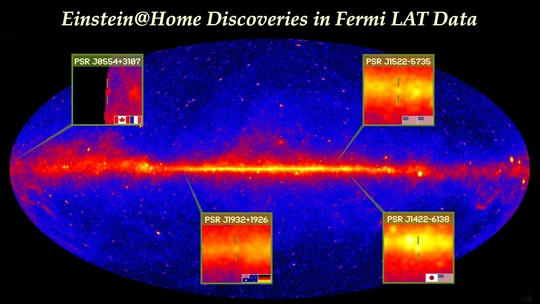Nov 27 2013
The combination of globally distributed computing power and innovative analysis methods proves to be a recipe for success in the search for new pulsars.
 All four gamma-ray pulsars discovered by Einstein@Home lie in the plane of our Milky Way, as shown in this sky map using data from Fermi's Large Area Telescope (LAT). The plane is apparent as an area of particularly intense gamma radiation; brighter colors indicate more intense radiation. The insets show the four pulsars as point sources. The flags indicate the nationalities of the Einstein@Home volunteers whose computers made the discoveries.Knispel/Pletsch/AEI/NASA/DOE/Fermi LAT Collaboration
All four gamma-ray pulsars discovered by Einstein@Home lie in the plane of our Milky Way, as shown in this sky map using data from Fermi's Large Area Telescope (LAT). The plane is apparent as an area of particularly intense gamma radiation; brighter colors indicate more intense radiation. The insets show the four pulsars as point sources. The flags indicate the nationalities of the Einstein@Home volunteers whose computers made the discoveries.Knispel/Pletsch/AEI/NASA/DOE/Fermi LAT Collaboration
Scientists from the Max Planck Institutes for Gravitational Physics and Radio Astronomy together with international colleagues have now discovered four gamma-ray pulsars in data from the Fermi space telescope. The breakthrough came using the distributed computing project Einstein@Home, which connects more than 200,000 computers from 40,000 participants around the world to a global supercomputer. The discoveries include volunteers from Australia, Canada, France, Germany, Japan, and the USA.
Since its launch in 2008, the Fermi satellite has been observing the entire sky in gamma-rays. It has discovered thousands of previously unknown gamma-ray sources, among which are possibly hundreds of yet undiscovered pulsars – compact and rapidly rotating remnants of exploded stars. Identifying these new gamma-ray pulsars, however, is computationally very expensive – wide parameter ranges have to be “scanned” at very high resolution.
“Our innovative solution for the compute intensive search for gamma-ray pulsars is the combination of particularly efficient methods along with the distributed computing power of Einstein@Home,” says Holger Pletsch, Independent Research Group Leader at the Max Planck Institute for Gravitational Physics (Albert Einstein Institute/AEI), and lead author of the study. “The volunteers from around the world enable us to deal with the huge computational challenge posed by the Fermi data analysis. In this way, they provide an invaluable service to astronomy,” says Pletsch.
Distributed Computing for Astronomy
Einstein@Home is a joint project of the Center for Gravitation and Cosmology at the University of Wisconsin–Milwaukee and the AEI in Hannover. It is funded by the National Science Foundation and the Max Planck Society. Since mid-2011, Einstein@Home has been searching for signals from gamma-ray pulsars in Fermi data. The project was founded in 2005 to search for gravitational-wave signals in data from the LIGO detectors – still the main task of Einstein@Home. Since early 2009, the project has also been conducting successful searches for new radio pulsars.
“The first-time discovery of gamma-ray pulsars by Einstein@Home is a milestone – not only for us but also for our project volunteers. It shows that everyone with a computer can contribute to cutting-edge science and make astronomical discoveries,“ says co-author Bruce Allen, director at the AEI and principal investigator of Einstein@Home. “I'm hoping that our enthusiasm will inspire more people to help us with making further discoveries.”